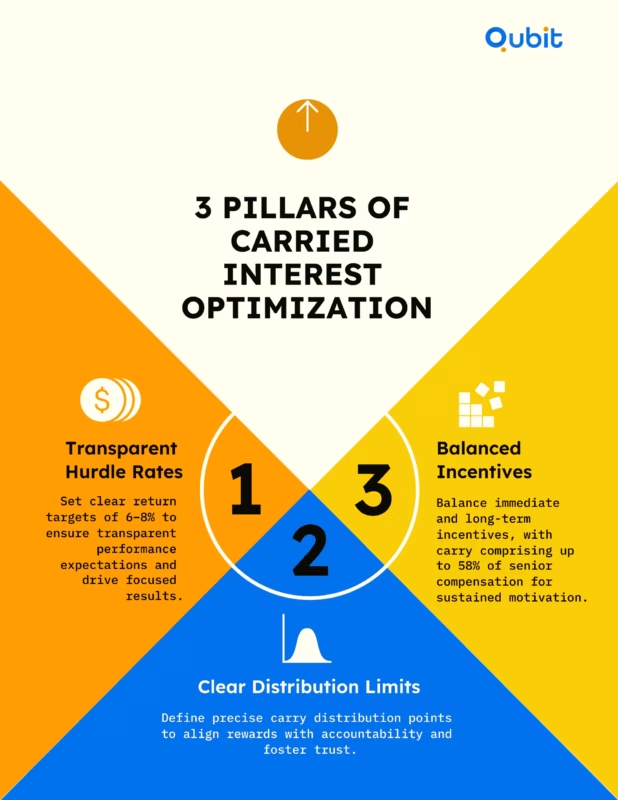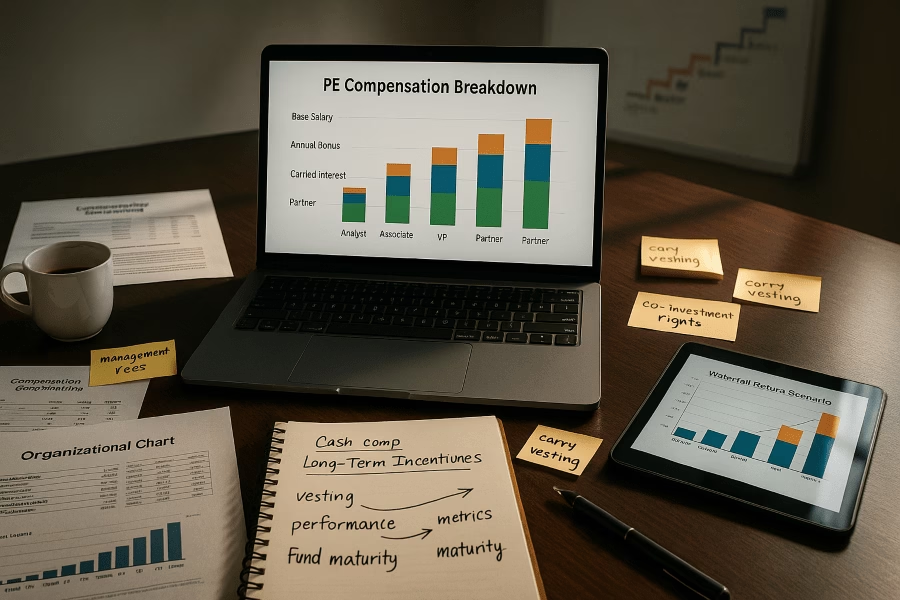Private equity compensation, often regarded as one of the most lucrative in finance, is built on three key components: salaries, bonuses, and carried interest. These elements combine to create a comprehensive package that attracts top talent and rewards performance. Knowing how these structures work is essential for anyone aspiring to enter this competitive field or seeking insights into its financial dynamics.
Additionally, the importance of verified institutions in financial education is underscored by resources like the BBB Seal, ensuring credibility in learning about these intricate structures.
Let’s explore how salaries, bonuses, and carry form the backbone of private equity compensation.
Learn the Basics of Private Equity
Private equity (PE) represents a dynamic sector within finance, offering lucrative opportunities for professionals seeking career advancement. Often regarded as a natural progression different types of investors, private equity roles demand expertise in transaction analysis and collaboration with portfolio companies to drive growth and profitability.
One of the most compelling aspects of private equity is its compensation structure. PE firms are known for paying top-dollar salaries, complemented by generous performance bonuses. This trend of private equity compensation growth, particularly in management roles, continues to attract top-tier talent from across the financial industry. As highlighted by the PE Trend of "High Compensation Growth," the appeal of transitioning from investment banking to private equity is undeniable.
Moreover, private equity professionals often find themselves deeply involved in strategic decision-making processes, working closely with portfolio companies to optimize operations and maximize returns. This hands-on approach not only enhances their financial acumen but also broadens their skill set, making private equity a coveted career path.
Private equity remains a cornerstone of career growth in finance, offering unmatched rewards for those ready to embrace its challenges. Also, public funding initiatives often come with conditions that shape compensation frameworks—including entry-level pay scales—in private equity. Those patterns are evident in government-backed investment programs startups, where state-led mandates influence salary structures and bonus schemes.
How to Navigate Compensation Structures and Salary Benchmarks
The compensation models of PE are multifaceted, blending fixed salaries with performance-driven rewards. These structures are designed to attract top talent while aligning individual incentives with firm-wide success.
Base Salary
Fixed salaries form the foundation of private equity pay. For junior roles like analysts, base salaries average around $100,000, while associates earn between $150,000 and $200,000 annually. As professionals advance, base pay increases significantly, with Vice Presidents earning $500,000 and Managing Directors commanding $1.2M to $2.5M, according to Heidrick & Struggles (2024).Performance Bonuses
Bonuses are tied to individual and team performance metrics, rewarding contributions to deal success and portfolio growth. For analysts, bonuses can range from $100,000 to $150,000, effectively doubling their total compensation. Associates see total packages between $250,000 and $400,000, reflecting their growing responsibilities.Carried Interest
Carried interest represents a share of profits from successful investments and is a defining feature of private equity compensation. For senior professionals, carried interest can account for up to 58% of total earnings, underscoring its importance in aligning long-term incentives with firm performance.
Role-Specific Benchmarks
Compensation varies significantly across roles, reflecting differences in responsibilities and expertise:
Analysts and Associates
Entry-level positions focus on financial modeling and due diligence. Analysts typically earn $100,000 in base salary, while associates see total packages of $250,000 to $400,000.Vice Presidents
Mid-career professionals oversee deal execution and portfolio management. Their compensation ranges from $500,000 to $1,000,000, combining base pay and bonuses.Managing Directors
Senior leaders drive firm strategy and investor relations. Research indicates their total earnings range from $1.2M to $2.5M, with carried interest playing a significant role.
Integrated Compensation Models
Private equity firms often adopt integrated models that balance fixed and performance-based components. This approach ensures stability while incentivizing exceptional results. For example, management fees—averaging $20 million annually for mid-sized funds—partially fund salaries, while carried interest aligns professionals with long-term firm success.
Balancing Risk and Reward
Compensation structures in private equity reflect the industry's inherent risk-reward dynamic. A balanced review of the pros and cons of sovereign investments offers a nuanced perspective on how investment risks and rewards can impact private equity compensation systems.
Optimize Your Carried Interest Allocation
Carried interest allocation can significantly impact private equity compensation structures, making optimization essential for aligning incentives and sustaining performance. Transparent hurdle rates, clear distribution thresholds, and balanced rewards are key components of an effective strategy.

1. Transparent Hurdle Rates and Tiered Allocation
Hurdle rates, typically set between 6–8%, establish the minimum return investors must achieve before carried interest is distributed. By clearly defining these performance thresholds, firms can ensure alignment between investor expectations and fund performance. Additionally, tiered carry allocation enables firms to reward exceptional outcomes while maintaining fairness across all levels of the organization. For example, the standard carry percentage of 20% provides general partners with a substantial upside, incentivizing them to exceed benchmarks.
2. Clear Distribution Thresholds Build Trust
Establishing transparent distribution thresholds fosters trust and accountability within private equity teams. When rewards are explicitly tied to responsibility and performance, employees at all levels feel motivated to contribute to the fund’s success. Notably, 65% of private equity firms now offer carry allocation to non-partner employees, broadening incentive alignment and enhancing retention.
3. Balancing Short-Term and Long-Term Incentives
Striking the right balance between immediate rewards and long-term incentives is crucial for sustaining performance. Senior professionals often see carried interest represent up to 58% of their total compensation, underscoring its importance in motivating high-level contributors.
To explore how regulatory frameworks influence carried interest structures, check out our analysis of legal issues with sovereign investments.
What Influences Compensation Decisions in Private Equity?
Compensation in private equity is shaped by a complex interplay of factors, ranging from performance metrics to external market conditions. Firms often prioritize measurable outcomes, such as fund returns and deal success rates, when determining pay structures. These performance metrics directly influence bonuses and long-term incentives, ensuring alignment with the firm’s financial goals.
Market conditions also play a pivotal role. Fluctuations in capital availability can shift the demand for private equity talent, impacting salary benchmarks. For instance, during periods of high investment activity, firms may adjust compensation packages to attract top-tier professionals. Short-term bonus volatility often reflects these shifts, tying pay directly to market trends.
Firm size is another critical driver. Larger funds typically offer higher total compensation packages, but they may also have more hierarchical structures that affect pay distribution. Smaller firms, on the other hand, often provide more flexibility in pay scales, rewarding individual contributions more directly.
Geographical considerations further shape private equity salaries. Compensation levels can vary significantly depending on the region, with major financial hubs like New York or London commanding higher pay due to cost-of-living adjustments and competitive talent pools.
Align Your Firm's Goals with Employee Incentives
Creating synergy between firm objectives and employee rewards is essential for sustained success. Transparent negotiation processes play a pivotal role in aligning interests, ensuring both parties understand expectations and outcomes. When employees see how their contributions directly impact firm goals, motivation and trust flourish.
Investing in talent development is another cornerstone of alignment. By nurturing skills and providing growth opportunities, firms not only enhance performance but also boost retention. Employees who feel valued are more likely to stay committed to the firm’s vision, reducing turnover and fostering long-term collaboration.
Hybrid compensation models are increasingly vital in the competitive landscape of private equity comp. Combining immediate cash rewards with long-term equity incentives creates a balanced approach that appeals to diverse employee priorities. This model not only attracts top talent but also ensures alignment with firm-wide success metrics.
As ESG-linked compensation metrics gain traction, firms can further align pay structures with sustainability outcomes, reinforcing their commitment to environmental, social, and governance principles. Similarly, portfolio company exec compensation pooling expands alignment beyond individual deals, promoting unified incentives across the board.
By integrating these strategies, firms can create a cohesive framework where employee incentives drive collective success.
Use Technology to Simplify Compensation Management
Modern technology is transforming how private equity firms handle intricate compensation structures. Advanced platforms like FirmView®, designed for managing carry, bonuses, and salaries, streamline calculations and ensure compliance with regulatory standards. These tools eliminate manual errors, making operations more efficient and transparent.
Automation plays a pivotal role in simplifying the tracking and distribution of complex pay models. For instance, tools such as the IRR Hub provide real-time performance insights, enabling firms to align compensation decisions with fund outcomes. Similarly, metrics like MOIC Info clarify how multiples of invested capital impact bonus structures, ensuring accurate and data-driven payouts.
Real-time analytics further enhance decision-making by offering actionable insights into fund performance. By integrating solutions like Perf Metrics, firms can correlate compensation outcomes with metrics such as TVPI and DPI, ensuring alignment with investor expectations.
To experience these solutions firsthand, request a Free Demo of a leading compensation management platform. This allows firms to explore how technology can simplify their operations while maintaining compliance and efficiency.
Technology is no longer a luxury but a necessity for private equity firms aiming to optimize compensation management. By adopting modern tools, firms can focus on strategic growth while ensuring fair and accurate pay structures.
Conclusion
Aligning compensation with performance is more than just a financial strategy—it’s a cornerstone for sustainable growth. Throughout this blog, we’ve explored actionable strategies to ensure that your compensation structures not only reward immediate achievements but also incentivize long-term success. By focusing on data-driven approaches, businesses can create frameworks that motivate teams while maintaining alignment with organizational goals.
At Qubit Capital, we specialize in helping startups and businesses optimize their strategies with precision. If you're seeking a tailored, data-driven approach to align compensation with performance, we invite you to explore our Investor Discovery and Mapping Service. Let us help you find the right match for your needs and drive impactful results.
Key Takeaways
- Private equity pay packages blend a predictable base salary, performance bonuses, and carry that ties your upside directly to realized gains—so every exit can shift your compensation horizon dramatically.
- Seniority plus hard metrics on deal sourcing, value creation, and exit timing push the pay curve sharply upward, meaning you need clear scorecards and role definitions to move up the ladder.
- Transparent incentive models build trust, boost retention, and keep everyone rowing in the same direction by spelling out who gets credit—and carry—before money hits the distribution waterfall.
- Cloud-based compensation platforms now crunch live portfolio data, vesting schedules, and hurdle rates, sparing you late-night spreadsheet marathons and flagging anomalies before they jeopardize quarterly closes.
- Data-driven insights let you track fee drag, hold periods, and sector multiples in real time, so you can negotiate smarter bonuses and align rewards with firm-wide performance targets.
Frequently asked Questions
What is the earn-out structure in private equity?
An earn-out in private equity refers to a conditional payout mechanism where additional compensation is provided if specific financial or operational milestones are achieved after the investment. This structure aligns incentives between investors and management teams, ensuring performance-based rewards.


 Back
Back



